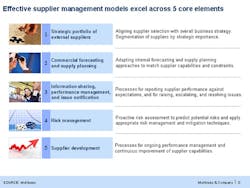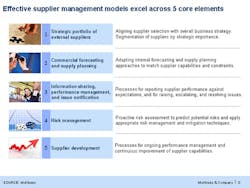Pharmaceutical manufacturers have seized the opportunity to cut costs, improve flexibility, and reduce risk by expanding their use of third-party manufacturing partners. Between 2001 and 2008, the pharmaceutical contract manufacturing industry doubled in size and, according to Frost & Sullivan, it is forecast to continue growing at a rate of 11 percent per year and is expected to be worth more than $26 billion by 2012. As the external supply base has grown, however, managers are increasingly recognizing the true complexities of the process. Industry leaders we speak to highlight challenges across the key areas of quality, delivery, and cost in managing their external supply relationships.
New Game, New Rules
These challenges are not insurmountable. Companies in other sectors have built effective mixed models of internal and external manufacturing. Now pharma companies are beginning to apply some of the same techniques. Strong supplier management requires companies to have the right processes for selecting suppliers, for managing their performance, and for developing their capabilities over time. Companies with the most effective supplier management models do this by getting five core elements right (see image).
1. They create a strategic portfolio of external suppliers.
Most companies have allowed their external supply base to grow organically, selecting and qualifying suppliers on an ad-hoc basis for particular projects, products, or markets. For some companies, this evolution has led to complex, expensive, and difficult to manage networks of more than 200 suppliers. The best firms, by contrast, take a much more rigorous approach. This starts by aligning the supplier selection process to overall business strategy. A company seeking cost leadership might aggressively seek low-cost country suppliers, for example, while another looking for technology leadership will want to forge collaborative relationships that give it access to critical skills and technologies.
Leaders also use sophisticated segmentation criteria when selecting and managing suppliers, including criticality of the product, supplier capabilities, the supply landscape, and others. Firms apply these criteria rigorously to the full supply base and use them to stratify the supply base for selection and, later, improve prioritization for active supplier management.
2. They improve their forecasting and supply planning approach.
While outsourcing may offer a compelling solution to the problems associated with demand volatility and capacity constraints, companies that expect these issues to disappear altogether will be disappointed. Suppliers have some opportunity to offset demand fluctuations between customers, but still have constraints on equipment capacity, people, and materials availability. Compensating for this requires planning across multiple horizons, working closely with suppliers to understand their true flexibility and constraints, and adapting internal forecasting and supply planning approaches to respond. In industries where variability is particularly high, such as high-tech, the best performing companies hold quarterly (or longer) equipment planning reviews with their suppliers, design their forecast processes to eliminate unnecessary demand fluctuations, and then work together to develop inventory and production scheduling rules that are tailored to particular products based on their value and variability.
3. They implement rigorous procedures for information sharing, performance management, and issue resolution.
Managing the performance of a supply chain becomes more difficult as more of it is outsourced. Companies frequently find that as they outsource manufacturing, for example, they lose sight of the vital production performance indicators that provide an early warning of potential supply issues. Likewise, their ability to rapidly resolve issues that do arise may be compromised because they lack the appropriate mechanisms for communicating and responding to them. Where an internal production manager would simply have picked up the phone to a colleague in logistics, for example, or discussed progress around the water cooler, a supplier may be unsure whom to call, and when.
Avoiding these issues requires companies to agree to an effective set of performance indicators with their suppliers – ideally the same ones they would have used when production was internal. It also requires them to implement formal protocols for the communication, escalation, and resolution of issues.
One company in the high tech sector, for example, suffered from quality and reliability issues when it outsourced some critical assemblies to an external supplier. Identifying and rejecting substandard parts was expensive and threatened to disrupt production, so the company to took steps to tackle the problem at the source. First, it designed a new set of daily, weekly, and monthly reports with the supplier to ensure early identification and resolution of potential issues. Then the company worked with its supplier to identify the individuals within their two organizations who were best placed to take action to resolve issues. Finally, it established a cascading issue resolution and tracking system to ensure those people were brought together quickly when required, and to allow tracking of issues for ongoing supplier management and continuous improvement efforts.
As a result of the effort, delivery performance from the supplier improved by more than 9 percent, helping the company to accelerate sales growth. Within six months it had also achieved cost savings from the supplier of more than 5 percent, thanks to the reduced complexity of managing the program.
4. They take a proactive approach to risk management.
The best companies hold suppliers to a level of risk management equal to their internal production facilities. Rather than taking a reactive approach to supplier risk management, relying on reviews of batch records and infrequent formal audits, these companies adopt a proactive, on-site risk assessment and problem-solving approach.
Others are already adopting an approach pioneered in the automotive sector to map the principal sources of quality risk in key suppliers. Risk “heat maps” use a company’s own knowledge of process risks to predict the parts of a supplier’s operation that have the largest potential to create problems. These heat maps can be used to identify critical criteria during supplier selection, and companies can engage directly with their existing suppliers to agree on appropriate risk management and mitigation techniques. For critical suppliers, top companies map the full operational taxonomy of past, current, and future risk in detail and carefully manage to those risks. One pharmaco, for example, developed a detailed risk management heat map for its own plants, allowing it to focus quality improvement efforts precisely where the biggest risks arose. Having proved the technique in-house, the company is now rolling out the same management and mitigation approach to its most important suppliers.
5. They systematically improve performance and develop supplier capabilities.
Supply chains can’t stand still. While outsourcing should deliver immediate one-off cost savings and performance improvements, companies must ensure they have mechanisms in place to driver further improvement over time. Simply placing suppliers under pressure to reduce their costs while increasing quality and delivery performance standards has proved frustratingly ineffective for many firms.
The best take a more collaborative approach. While they keep up the pressure for suppliers to improve their KPIs, they also work with them to identify ways in which the performance of the entire value chain can be lifted. Supplier development, in which engineers from the procuring organization spend time working on site with suppliers to fix problems and develop innovative new solutions, is common in the automotive and high tech industries. Now it is delivering benefits in pharma too. A project at one large pharmaco, for example focused on developing the skills of a select group of its own production engineers. Once they had gained considerable expertise in identifying and fixing production inefficiencies and quality issues, the company embarked on a program to share that expertise in a structured way with key suppliers. In this program the company sends its engineers to work in supplier plants alongside supplier production staff, helping them to tackle specific issues and to build their own process improvement capabilities. So far, the project has been a considerable success, delivering 5 to 10 percent cost savings annually, together with improved supply reliability.
As they ramp up their use of outsourced manufacturing, pharmacos must be prepared to tackle new challenges. While it is still early days for the industry, those companies that are embracing the best practices developed in other sectors are finding that they can deliver big benefits in pharma too.







